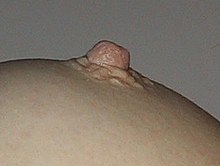This is an old revision of this page, as edited by For great justice. (talk | contribs) at 17:22, 9 May 2006. The present address (URL) is a permanent link to this revision, which may differ significantly from the current revision.
Revision as of 17:22, 9 May 2006 by For great justice. (talk | contribs)(diff) ← Previous revision | Latest revision (diff) | Newer revision → (diff) This article is about anatomical structure. For nipple (disambiguation), see Nipple (disambiguation).In its most general form, a nipple is an appurtenance from which a fluid emanates, in this instance breast milk, to nurture a mother's young.
Anatomy
In the anatomy of mammals, a nipple or mammary papilla is a small projection of skin containing the outlets for 15-20 lactiferous ducts arranged cylindrically around the tip. The physiological purpose of nipples is to deliver milk produced in the female mammary glands during lactation to the infant. In the male, nipples are often not considered functional with regard to breastfeeding, although male lactation is possible. Mammalian infants have a rooting instinct for seeking the nipple, and a sucking instinct for extracting milk.
Mammals typically have an even number of nipples arranged bilaterally. Rarely, as in the platypus, the mammary glands empty onto the skin without a nipple.

In human anatomy, the two nipples are located near the center of the breasts, surrounded by an area of sensitive, pigmented skin known as the areola. The nipple and areola can be erotic receptors, or considered sex organs, of males and females. Stimulation or sexual arousal can cause the nipples to become erect. Breastfeeding or exposure to cold temperatures often have this effect as well. Pregnancy and nursing tend to increase nipple size somewhat, and this increase may remain permanently thereafter. Small non-striated myocytes (muscle cells) arranged cylindrically within the nipple are responsible for this erection of the nipples.

Embryologically, nipples develop along the 'milk lines' which in humans extend from the axilla (armpit) down to the pubis (groin) on both sides. Other mammals such as cats and dogs develop more nipples along the milk lines, in number generally approximating the average litter size for that species, rounded up to an even number. Most people develop two nipples (one on each breast) but some have supernumerary nipples. Occasionally, these have lactiferous glands attached.
Sometimes, babies (male or female) are born producing milk. This, called "witch's milk", is caused by maternal estrogens acting on the baby and is quite normal. Witch's milk disappears after several days.
See also
- List of sexology topics : Areola, Breast, Erection, Male lactation, Masters and Johnson, Masturbation, Nudity, Sex organ, Sexual arousal
- Biological development : Breastfeeding, Infant, Inverted nipple, Oxytocin, Prolactin, Supernumerary (third) nipple, Tit, Wet nurse, Witch's milk
- Modification methods : Nipple piercing, Body nullification, Jewellery
References
- Stephen Jay Gould. Male Nipples and Clitoral Ripples. in Adam's Navel and Other Essays. London: Penguin, 1995.